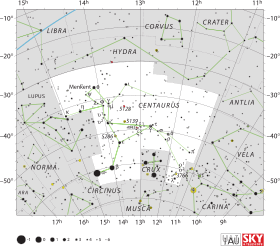Gamma Centauri
 | |
| Observation data Epoch J2000 Equinox J2000 | |
|---|---|
| Constellation | Centaurus |
| Right ascension | 12h 41m 31.04008s[1] |
| Declination | −48° 57′ 35.5375″[1] |
| Apparent magnitude (V) | +2.17[2] (+2.85/+2.95)[3] |
| Characteristics | |
| Spectral type | A1IV+[4] (A0III/A0III)[5] |
| U−B color index | −0.01[2] |
| B−V color index | −0.01[2] |
| Astrometry | |
| Radial velocity (Rv) | −5.5[6] km/s |
| Proper motion (μ) | RA: −185.72[1] mas/yr Dec.: +5.79[1] mas/yr |
| Parallax (π) | 25.06 ± 0.28[1] mas |
| Distance | 130 ± 1 ly (39.9 ± 0.4 pc) |
| Absolute magnitude (MV) | –0.81[5] |
| Orbit[7][8] | |
| Companion | γ Centauri B |
| Period (P) | 83.57 yr |
| Semi-major axis (a) | 0.869″ |
| Eccentricity (e) | 0.793 |
| Inclination (i) | 113.7° |
| Longitude of the node (Ω) | 2.6° |
| Periastron epoch (T) | 1931.25 |
| Argument of periastron (ω) (secondary) | 187.9° |
| Details | |
| Mass | 2.91[9] M☉ |
| Surface gravity (log g) | 3.52[4] cgs |
| Temperature | 9,082[4] K |
| Other designations | |
| Database references | |
| SIMBAD | data |
Gamma Centauri (γ Cen, γ Centauri) is a star in the southern constellation Centaurus. It has the proper name Muhlifain,[10] not to be confused with Muliphein, which is γ Canis Majoris; both names derive from the same Arabic root.
Gamma Centauri is a double star located about 130 light-years (40 parsecs) from Earth. The combined apparent visual magnitude of the pair is +2.17,[2] although individually they are third magnitude stars.[3] The stellar classification of the pair is A1IV+,[4] suggesting they are A-type subgiant stars in the process of becoming giants. Individually, their stellar classifications are sometimes listed as A0III, which would mean they have already become giants.[5]
In 2000, the pair had an angular separation of 1.217 arcseconds with a position angle of 351.9°.[3] Their positions have been observed since 1897, which is long enough to estimate an orbital period of 84.5 years and a semimajor axis of 0.93 arcseconds.[7] At the distance of this system, this is equivalent to a linear distance of about 93 Astronomical Units.[11] The star Tau Centauri is relatively close to Gamma Centauri, with an estimated separation of 1.72 light-years (0.53 pc).[9]
Etymology
In Chinese, 庫樓 (Kù Lóu), meaning Arsenal, refers to an asterism consisting of γ Centauri, ζ Centauri, η Centauri, θ Centauri, 2 Centauri, HD 117440, ξ1 Centauri, τ Centauri, D Centauri and σ Centauri.[12] Consequently, γ Centauri itself is known as 庫樓七 (Kù Lóu qī, English: the Seventh Star of Arsenal.)[13]
The people of Aranda and Luritja tribe around Hermannsburg, Central Australia named Iritjinga, "The Eagle-hawk", a quadrangular arrangement comprising this star, δ Cen (Ma Wei), δ Cru (Imai) and γ Cru (Gacrux), .[14]
References
- 1 2 3 4 5 van Leeuwen, F. (November 2007). "Validation of the new Hipparcos reduction". Astronomy and Astrophysics. 474 (2): 653–664. arXiv:0708.1752. Bibcode:2007A&A...474..653V. doi:10.1051/0004-6361:20078357.
- 1 2 3 4 Johnson, H. L.; et al. (1966). "UBVRIJKL photometry of the bright stars". Communications of the Lunar and Planetary Laboratory. 4 (99): 99. Bibcode:1966CoLPL...4...99J.
- 1 2 3 Fabricius, C.; Makarov, V. V. (April 2000). "Two-colour photometry for 9473 components of close Hipparcos double and multiple stars". Astronomy and Astrophysics. 356: 141–145. Bibcode:2000A&A...356..141F.
- 1 2 3 4 Gray, R. O.; et al. (July 2006). "Contributions to the Nearby Stars (NStars) Project: Spectroscopy of Stars Earlier than M0 within 40 pc-The Southern Sample". The Astronomical Journal. 132 (1): 161–170. arXiv:astro-ph/0603770. Bibcode:2006AJ....132..161G. doi:10.1086/504637.
- 1 2 3 Schaaf, Fred (2008). The brightest stars: discovering the universe through the sky's most brilliant stars. The Brightest Stars: Discovering the Universe through the Sky's Most Brilliant Stars. John Wiley and Sons. p. 262. Bibcode:2008bsdu.book.....S. ISBN 0-471-70410-5.
- ↑ Evans, D. S. (June 20–24, 1966). Batten, Alan Henry; Heard, John Frederick, eds. The Revision of the General Catalogue of Radial Velocities. University of Toronto: International Astronomical Union. Bibcode:1967IAUS...30...57E.
- 1 2 Mason, Brian D.; et al. (December 2001). "The 2001 US Naval Observatory Double Star CD-ROM. I. The Washington Double Star Catalog". The Astronomical Journal. 122 (6): 3466–3471. Bibcode:2001AJ....122.3466M. doi:10.1086/323920.
- ↑ "Sixth Catalog of Orbits of Visual Binary Stars".
- 1 2 Shaya, Ed J.; Olling, Rob P. (January 2011). "Very Wide Binaries and Other Comoving Stellar Companions: A Bayesian Analysis of the Hipparcos Catalogue". The Astrophysical Journal Supplement. 192 (1): 2. arXiv:1007.0425. Bibcode:2011ApJS..192....2S. doi:10.1088/0067-0049/192/1/2.
- ↑ Paul Kunitzsch (1959). Arabische Sternnamen in Europa, von Paul Kunitzsch. O. Harrassowitz. p. 188.
- ↑ Kaler, James B. "MUHLIFAIN (Gamma Centauri)". Stars. University of Illinois. Retrieved 2011-12-31.
- ↑ (in Chinese) 中國星座神話, written by 陳久金. Published by 台灣書房出版有限公司, 2005, ISBN 978-986-7332-25-7.
- ↑ (in Chinese) 香港太空館 - 研究資源 - 亮星中英對照表 Archived January 30, 2011, at the Wayback Machine., Hong Kong Space Museum. Accessed on line November 23, 2010.
- ↑ p. 8, Explorers of the southern sky: a history of Australian astronomy, Raymond Haynes, Cambridge, Cambridge University Press, 1996.